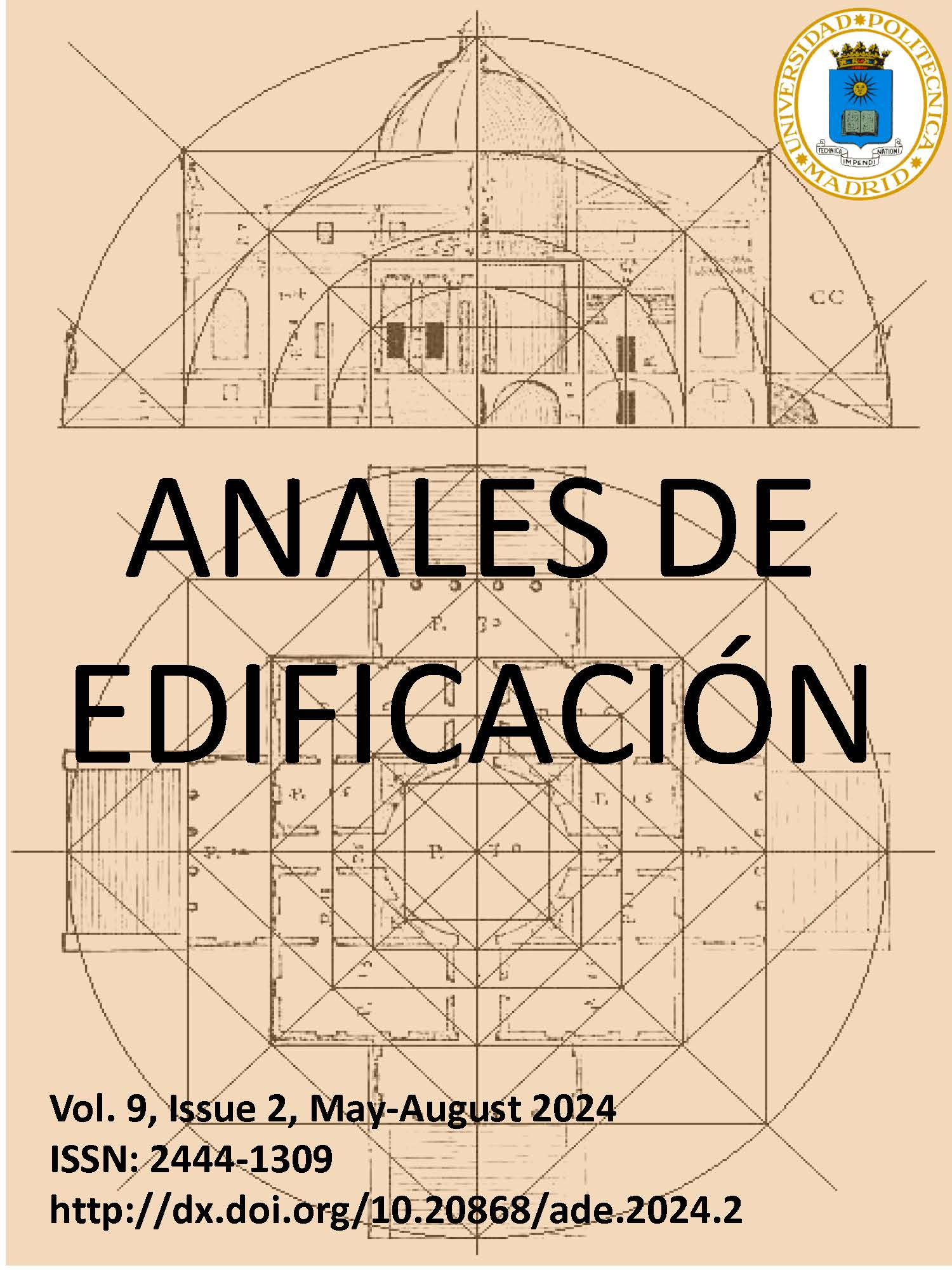Volumetric distribution for the use of solar energy. Case study in Soria, Spain
DOI:
https://doi.org/10.20868/ade.2024.5365Keywords:
Solar Energy, shade analysis, architectural design, environmental simulation tools, solar energyAbstract
In the field of construction, it is necessary to design buildings taking into account the use of solar energy. Currently, the most commonly used tools in the discipline provide qualitative results based on experimentation and do not consider the testing of multiple options in the design stages. The aim of this work is to facilitate this task and provide an evaluation process based on the detailed comparison of different situations. The proposed methodology consists of 3 stages (i. Present situation, ii. Formulation of alternatives and iii. Comparison of results) and is supported by user-friendly software familiar with the built environment. As a case study, the extension of a light modular structure located in Soria (Spain) was adopted. The study allowed to determine the impact of the shadows generated on the building of interest, which provided new bases for the project authorities to make decisions.
Downloads
References
1. Balsari, S. M.; Boutet, M. L. “Estrategias para el aprovechamiento y control de la luz solar en espacios arquitectínicos culturales y patrimoniales de la región NEA,” Comun. Científicas y Tecnológicas Anu. 2020, pp. 83–97, 2021, [Online]. Available: http://repositorio.unne.edu.ar/handle/123456789/30201.
2. Buonomano, A.; Calise, F.; Ferruzzi, G.; Palombo, A. “Dynamic energy performance analysis: Case study for energy efficiency retrofits of hospital buildings,” Energy, vol. 78, pp. 555–572, 2014, doi: 10.1016/j.energy.2014.10.042.
3. Chazarra Bernabé, A.; Lorenzo Mariño, B.; Romero Fresneda, R.; Moreno García, J. V. “Evolución de los climas de Köppen en España en el periodo 1951-2020,” 2022. doi: 10.31978/666-22-011-4.
4. Choi, Y.; Kobashi, T.; Yamagata, Y.; Murayama, A. “Assessment of Waterfront Office Redevelopment Plan on Optimal Building Arrangements with Rooftop Photovoltaics: A Case Study for Shinagawa, Tokyo,” Energies, vol. 15, no. 3, p. 883, Jan. 2022, doi: 10.3390/en15030883.
5. Discoli, C. A.; Viegas, G. M.; San Juan, G. A. “Viviendas bioclimaticas en Tapalque. Sistema de climatización por muros acumuladores de calor (MAC): Resultados preliminares,” Av. en energias Renov. y medio Ambient., vol. 15, pp. 1–41, 2011.
6. EnergyPlus, “EnergyPlus,” EnergyPlus website, 2015. https://energyplus.net/ (accessed Sep. 15, 2021).
7. Fondoso Ossola, S. T.; Sphar, G.; Anido, G. “Herramienta Digital para la Simulación y Análisis de la Radiación Solar en Edificios (HD-SARSE),” Mendeley Data, 2022. https://doi.org/10.17632/6hvwtnfk8v.7 (accessed Mar. 15, 2023).
8. Fondoso Ossola, S. T.; Cristeche, J.; Chévez, P.; Barbero, D. A.; Martini, I. “Metodología para la Evaluación del Potencial Solar en Establecimientos Hospitalarios,” Av. en Energías Renov. y Medio Ambient., vol. 25, pp. 98–108, 2021, [Online]. Available: https://avermaexa.unsa.edu.ar/index.php/averma/article/view/154/39.
9. Fondoso Ossola, S. T.; Cristeche, J.; Chévez, P.; Barbero, D. A.; Martini, I. “Construcción de una Herramienta Digital para la Simulación y el Análisis de la Radiación Solar sobre Edificios,” Av. en Energías Renov. y Medio Ambient., vol. 25, pp. 352–362, 2021, Accessed: Sep. 16, 2022. [Online]. Available: http://portalderevistas.unsa.edu.ar/ojs/index.php/averma/article/view/2432.
10. McNeel, R. “Grasshopper: algorithmic modeling for Rhino,” Grasshopper website, 2023. https://www.grasshopper3d.com/ (accessed Mar. 15, 2023).
11. Nematchoua, M. K. et al., “Comparative analysis of bioclimatic zones, energy consumption, CO2 emission and life cycle cost of residential and commercial buildings located in a tropical region: A case study of the big island of Madagascar,” Energy, vol. 202, p. 117754, 2020, doi: 10.1016/j.energy.2020.117754.
12. Rhinoceros, “food4Rhino,” https://www.food4rhino.com/en, 2015. https://www.food4rhino.com/es (accessed Sep. 19, 2021).
13. Rhinoceros, “Rhino - Características,” Rhinoceros 3D website, 2015. https://www.rhino3d.com/features/#administración (accessed Sep. 16, 2021).
14. Sadeghipour Roudsari, M.; Mackey, C. “Ladybug Tools,” Ladybug Tools website, 2018. http://ladybug.tools/about.html (accessed Dec. 12, 2021).
15. Sansaniwal, S. K.; Sharma, V.; Mathur, J. “Energy and exergy analyses of various typical solar energy applications: A comprehensive review,” Renew. Sustain. Energy Rev., vol. 82, no. January, pp. 1576–1601, 2018, doi: 10.1016/j.rser.2017.07.003.
16. Tarkar, P. “Role of green hospitals in sustainable construction: Benefits, rating systems and constraints,” Mater. Today Proc., vol. 60, pp. 247–252, 2022, doi: 10.1016/j.matpr.2021.12.511.
17. Trimble, “SketchUp 2018,” SketchUp website, 2013. https://www.sketchup.com/es/products/sketchup-pro (accessed Dec. 23, 2021).
18. TRNSYS, “Welcome | TRNSYS : Transient System Simulation Tool,” Trnsys website, 2019. http://www.trnsys.com/ (accessed Sep. 15, 2021).
19. van Rossum, G. “Phyton,” Python website, 2023. https://www.python.org/ (accessed Mar. 15, 2023).
20. Zhang, J. et al., “Impact of urban block typology on building solar potential and energy use efficiency in tropical high-density city,” Appl. Energy, vol. 240, no. January, pp. 513–533, 2019, doi: 10.1016/j.apenergy.2019.02.033.
Downloads
Published
Issue
Section
License
Copyright (c) 2025 Autor / BY-NC

This work is licensed under a Creative Commons Attribution-NonCommercial-NoDerivatives 4.0 International License.
Anales de Edificación does not charge authors for processing or publishing an article and provides immediate Open Access to its content. All content is available free of charge to the user or his institution. Users are permitted to read, download, copy, distribute, print, search or link to the full text of articles, or use them for any other lawful purpose, without prior permission from the publisher or author. This is in accordance with the BOAI definition of open access.
- Authors retain the copyright and grant to the journal the right to a Creative Commons attribution / Non-Commercial / Non-Derivative 4.0 International (CC BY NC ND) License that allows others to share the work with an acknowledgement of authorship and non-commercial use.
- Authors may separately establish additional agreements for the non-exclusive distribution of the version of the work published in the journal (for example, placing it in an institutional repository or publishing it in a book).
Unless otherwise indicated, all contents of the electronic edition are distributed under a Creative Commons license.












